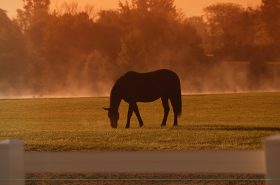You’ve likely heard the saying, “no hoof, no horse” and this is quite true.
The horse’s hooves are more than just “fingernails”—they’re important structures that should be given
the respect and care they deserve! With that said, here are 4 important things to know about your horse’s hooves:
1.) Hoof Growth Rate
It’s true that the outer part of the hoof, known as the hoof wall, is made of keratin, the same
substance that makes up our fingernails. And like our fingernails, the hoof wall is constantly
growing. On average, a horse grows a new hoof wall at a rate of about 1/4 inch per month.
However, the growth rate can vary depending on several factors, including the age of the horse,
the diet, genetics, as well as the time of year. For example, hoof growth is slower in winter than
it is in spring and summer.
2.) The Importance of the Frog
The frog is the rubbery V-shaped part of the bottom of the hoof that acts as both a cushion and
a shock absorber. It also helps with traction on slippery ground. Incidentally, the frog is
sometimes referred to as the horse’s “second heart” because it acts as a pump to help push
blood back up the leg. However, it can only work this way if it comes in contact with the ground!
3.) Weight-Bearing Structures
You may not have thought too much about which part of the hoof is meant to bear the horse’s
weight, but the truth is that it’s not just one part, but three: the hoof wall, frog, and bars (parts of
the hoof wall that turns inward from the heels, situated on either side of the frog) are all meant to
bear the horse’s weight. Therefore, they should all be in contact with the ground to
serve this purpose!
4.) The Coffin Bone
The coffin bone, also known as the third phalanx, P3, or the pedal bone, is a very important
inner structure of the hoof. This bone is connected to the inner hoof wall by laminae, fingerlike
tissues that have two layers: the insensitive outer layer and the sensitive inner layer (containing
blood supply and nerves). When a horse experiences laminitis (aka, founder), there is a
breakdown or inflammation of the laminae, resulting in a “sinking” or rotation of the coffin bone.



